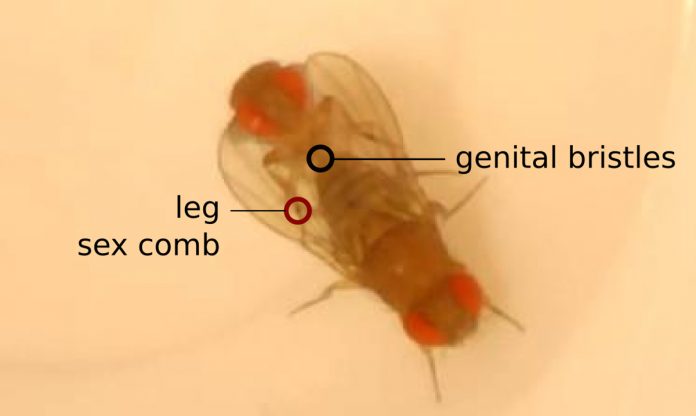
Virginie Courtier-Orgogozo, Directeur de recherche at CNRS explains an aspect of genetics that concerns understanding the origins of our biological traits
Millions of species inhabit our planet. Each species is characterised by a series of biological traits that enable organisms to live successfully in their ecological niches. Determining how these biological traits have evolved is fundamental to understanding biodiversity and the specificity of each species. Dr Courtier-Orgogozo and her team, from CNRS and the Institut Jacques Monod in Paris, use fruit flies as a model species and employ a cutting-edge multi-level approach, financed by an ERC Starting Grant, to decipher the fine mechanisms of evolution. Recently, her team made an important discovery about the contingency of evolution.
We humans, when compared to our closest living relatives the chimpanzees, have bigger brains, a sophisticated language, longer hair on the head and fewer hairs on the body. To understand what makes us what we are, as human beings or as individuals, it is important to explore the origins of our traits. Observable differences between species are due to mutations that accumulated in the DNA over multiple generations. For example, several millions of mutations occurred in our genome since our divergence from the chimpanzee lineage. Some of these mutations have no visible effects, while others have led to visible modifications of our brain, our eyes, or our predisposition to certain diseases. It is commonly thought that each species-specific trait evolved independently, through independent mutations. However, it is unclear whether several biological traits might co-evolve all at once due to a single mutation in the DNA.
As it is difficult to explore such a question in humans and chimpanzees, we decided to turn to two closely related species of fruit flies, Drosophila yakuba and Drosophila santomea. These fruit flies are great organisms for research because we can easily cross them in the laboratory to produce hybrids, a process in which pieces of DNA from one species are introduced in the genome of another species, and thus explore the consequences of such a genetic mix. Furthermore, many genetic tools, including CRISPR-Cas9, can be easily used in the closely-related species D. melanogaster to examine the effect of particular mutations of interest.
Drosophila yakuba and Drosophila santomea live in Africa and they co-exist on the island of São Tomé, off the coast of Africa. These species diverged about one million years ago and their DNA sequence is extremely similar. D. yakuba and other species have two sensory bristles on a particular region of their genitals whereas D. santomea has none. On the other hand, D. santomea has more sensory bristles on their forelegs than does D. yakuba. Both types of bristles are found only in males and appear to be used to grasp the female during copulation.
Our goal was to examine whether the loss of bristles on the genitalia and the gain of bristles on the leg could have originated through a single mutational event during evolution. Using advanced genetic mapping methods, we found that the loss of genital bristles is caused by mutations clustering around a particular gene called scute, which is very important for bristle development in insects. Without this gene, no bristles form and when the gene is over-expressed extra bristles form. In D. yakuba, the scute gene is highly expressed in the developing genitals, so that two bristles are formed in the genitals, and also in the developing forelegs so that eight to nine bristles are produced.
We tested the effect of our candidate mutations in D. melanogaster and we found that one mutation is particularly interesting. This mutation changes only one letter in the DNA. It causes the scute gene to be expressed at a lower level in D. santomea compared to D. yakuba, and thus no genital bristles are formed. This same mutation increases expression of the scute gene in the developing foreleg, thus leading to extra leg bristles in D. santomea compared to D. yakuba.
Based on our results we, therefore, concluded that a single letter change in the DNA, which occurred during the evolution of D. santomea, has contributed to both a loss of genital bristles and a gain of leg bristles. It is important to note that the effect of this mutation is small: other mutations also contributed to the species difference in leg and genital bristle number.
Our study shows that several traits can co-evolve all at once due to one mutation of a single letter in the DNA. The various traits that make us human may not have appeared individually one by one during our evolution. It is possible that some of our species-specific traits are just by-products of mutations that evolved for other reasons. Evolutionary studies such as ours are important to better understand the role of contingency in life evolution, past and future.
Further reading
Video abstract
Correlated evolution of two copulatory organs via a single cis-regulatory nucleotide change . Nagy O., I. Nuez, R. Savisaar, A. E. Peluffo, A. Yassin, M. Lang, D. L. Stern, D. R. Matute, J. R. David & V. Courtier-Orgogozo. Current Biology, 18 oct. 2018. Link DOI : https://doi.org/10.1016/j.cub.2018.08.047
Please note: this is a commercial profile
Virginie Courtier-Orgogozo
Directeur de recherche CNRS
Institut Jacques Monod – Université Paris Diderot
Tel: +33 1 57 27 80 43










